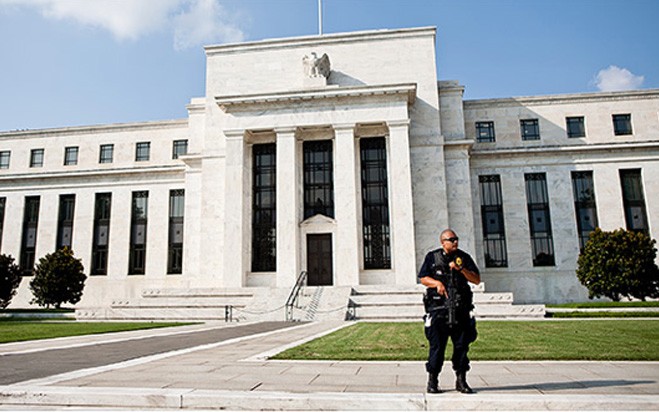
As a former Federal Reserve official, I was responsible for the Fed’s first plunge into the bond-buying experiment known as quantitative easing.
The central bank continues to spin QE as a tool for helping Main Street. But I’ve come to recognize the program for what it really is: the greatest backdoor Wall Street bailout of all time.
Five years ago this month, the Fed said it wanted to help. I was working on Wall Street in spring 2009 when I got an unexpected phone call. Would I come back to work on the Fed’s trading floor?
The job: managing a wild attempt to buy $1.25 trillion in mortgage bonds in 12 months. The idea was to reduce the cost of credit so more Americans could use it to weather the downturn.
Incredibly, the Fed was calling to ask if I wanted to quarterback the largest economic stimulus in U.S. history.
This was a dream job, but I hesitated. And it wasn’t just nervousness about taking on such responsibility.
I had left the Fed out of frustration, having witnessed the institution deferring more and more to Wall Street.
Senior Fed officials, though, were publicly acknowledging mistakes and several emphasized to me how committed they were to a major Wall Street revamp.
So I took a leap of faith.
In its almost 100-year history, the Fed had never bought one mortgage bond. Now my program was buying so many each day, that we constantly risked crashing global confidence in key financial markets.
It wasn’t long before my old doubts resurfaced. Despite the Fed’s rhetoric, my program wasn’t helping to make credit any more accessible for the average American.
QE may have been driving down the wholesale cost for banks to make loans, but Wall Street was pocketing most of the extra cash.
From the trenches, several other Fed managers also began voicing the concern that QE wasn’t working as planned.
Our warnings fell on deaf ears.
In the past, the Fed would have worried about the costs versus the benefits of any major initiative.
Now the only obsession seemed to be with the reaction of Wall Street bankers and hedge-fund managers.
Sorry, U.S. taxpayer.
Trading for the first round of QE ended on March 31, 2010. The final results confirmed that, while there had been only trivial relief for Main Street, the U.S. central bank’s bond purchases had been an absolute coup for Wall Street.
The banks hadn’t just benefited from the lower cost of making loans. They’d also enjoyed huge capital gains on the rising values of their securities holdings and fat commissions from brokering most of the Fed’s QE transactions.
You’d think the Fed would have finally stopped to question the wisdom of QE.
Think again.
Only a few months later—after a 14% drop in the U.S. stock market and renewed weakening in the banking sector—the Fed announced a new round of bond buying: QE2.
Germany’s finance minister, Wolfgang Schäuble, immediately called the decision “clueless.”
That was when I realized the Fed had lost any remaining ability to think independently from Wall Street.
Demoralized, I returned to the private sector.
Where are we today? The Fed keeps buying roughly $85 billion in bonds a month, chronically delaying so much as a minor QE taper. Over five years, its bond purchases have come to more than $4 trillion.
And the impact?
A $4 trillion dollar “investment” has returned a mere $40 billion bump in economic output.
Where did the other $3.96 trillion go?
As any occupier will tell you, it went to Wall Street banks. But the important question isn’t where did it go, the important question is: how did it get there?
The hand that takes is below the hand that gives.
As for the rest of America, good luck. Because QE killed the urgency for Washington to confront a real crisis: that of a structurally unsound U.S. economy.
Institutions that were meant to fail, that practiced corrupt or unwise business practices, that we should have been rid of years ago, are relentlessly kept alive by infusions of cash from the Fed.
Yes, financial markets have rallied, breathing life back into 401(k)s, and exuberance on Main Street, but for how long?
Critic’s warnings of inflation resulting from QE have been mostly dismissed, as consumer prices have risen only slightly.
But instead of soaring prices for groceries and gasoline, inflation has come to the stock market. Productive output stays the same, but the numbers keep getting bigger.
Since QE began, the market has tripled. Based on what?
Even when acknowledging QE’s shortcomings, Chairman Bernanke argues that some action by the Fed is better than none – a position his successor, Janet Yellen, also embraces.
The implication is that the Fed is dutifully compensating for the rest of Washington’s dysfunction.
But the Fed is at the center of that dysfunction, by allowing QE to become Wall Street’s new “too big to fail” policy.
Mr. Huszar, a senior fellow at Rutgers Business School, is a former Morgan Stanley managing director. In 2009-10, he managed the Federal Reserve’s $1.25 trillion agency mortgage-backed security purchase program.
This is a great article. I do have a question though: is the Fed really a government agency? If Wall Street made a killing at the expense of millions of citizens- the government is a puppet of the Fed. It is not really in the hands of the government to decide who gets richer or poorer. It is in the hands of the handful of private banking institutions- a few wealthy men. The history behind the fed is fascinating. Can you shed more light on this notion- especially since you were directly involved with the Fed.
🙂